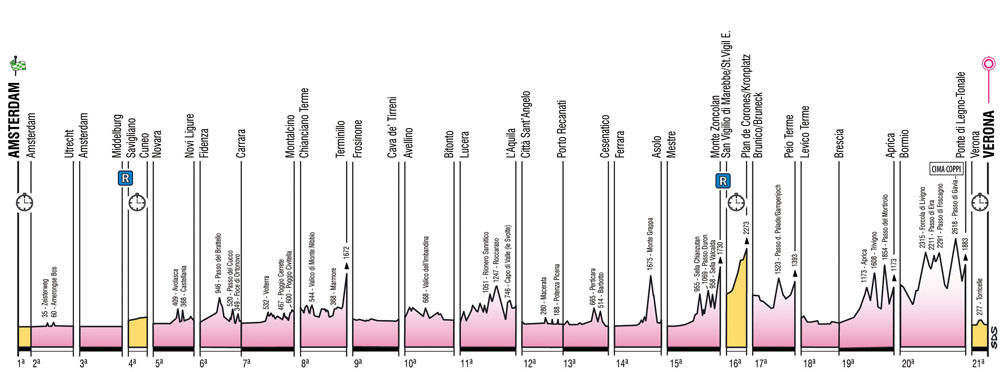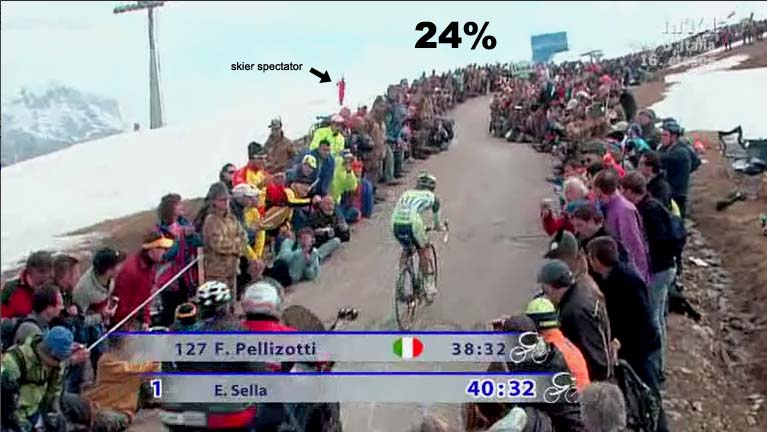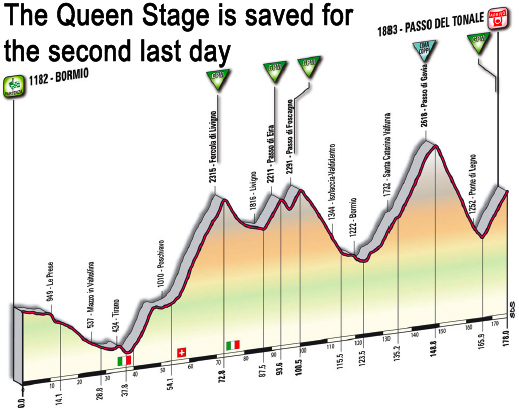Giro d’Italia
The 2010 Giro d’Italia offers a feast for the climbers, though the Italian grand tour opens on the flat roads of the Netherlands. This edition marks only the ninth time in its history that the Giro has started outside Italy. Difficult climbing characterizes this Giro, and the course includes visits to the Terminillo, Zoncolan, Mortirolo, Gavia, and Plan de Corones. The Giro includes four time trials this time around: A prologue in Amsterdam, a team time trial of 32.5 kilometers, an uphill test on the Plan de Corones, and a 15.3 kilometer finale around Verona. Still, in a shift from last year, the mountain stages should prove decisive in the race for the Maglia Rosa.
This Giro covers much of the Italian peninsula, and runs counter-clockwise from its start in Amsterdam to the finish in Verona. The Giro rolls from Piedmont on the northern border with France to the Amalfi Coast, then travels across to Adriatic Coast. From Bitonto, the Giro travels north along the Adriatic and passes through l’Aquila in a commemoration of the earthquake which caused widespread destruction in the city. Then, it’s on to Venezia and the Monte Zoncolan near Italy’s northern border. The final week lingers in Trentino and Lombardia in the north near Switzerland before the final time trial in Verona. The Giro celebrates the career of Fausto Coppi with a stage in Novi Ligure.
It’s all flat roads for the first three stages in the Netherlands. The Amsterdam prologue begins at the Van Gogh Museum and traces out a flat 8.4 kilometer course through the center of the city. Two sprint stages follow the prologue and run between Amsterdam and Utrecht and Amsterdam and Middleburg. A chance of crosswinds could complicate these stages which run close to the coast of the North Sea. Most likely, though, the sprinters will have their fun in these opening stages.
After the Dutch party, the Giro returns to Italy, touching down in Piedmont. The first stage in Italy is a team time trial of 32.5 kilometers between Savigliano and Cuneo. A strong team could gain a nice advantage for their team leader on this stage, but the relatively short distance should keep the general classification contenders well within the same time zone. After celebrating Fausto Coppi with a sprinters’ stage in Novi Ligure, the Giro continues its southward journey with two bumpy stages running from Fidenza to Carrara and Carrara to Montalcino. Classics riders like Alessandro Ballan, who will make his Giro début in 2010, should enjoy the stage to Montalcino, which includes stretches of gravel roads. The first mountain-top finish comes early in the second week at the finale of a stage running from Chianciano Terme in Toscana to the Terminillo in the Appenino not far from Roma.

After the first mountain top finish, the Giro returns to the flat lands with two stages for the sprinters from Frosinone to Cava de’Tirreno, which finishes just inland from the Amalfi Coast, and Avellino to Bitonto, which passes through Campania to the Adriatic Coast. As it heads deeper into Abruzzo, the Giro races over bumpy territory in the earthquake country around l’Aquila, which hosts the finish of a hilly 256 kilometer stage from Lucera. Two relatively flat stages follow the finish in l’Aquila, as the Giro races north through Porto Recanati and Cesenatico. From Cesenatico, there’s a transfer to Ferrara in Emilia-Romagna, and the final week of the Giro is a hilly affair through Venezia, Trentino, and Lombardia.
A stage running between Ferrara and Asola includes the Monte Grappa, an 18 kilometer climb which ramps up to a steep 14%. It’s a long descending finish, to Asola, but the following stage finishes on the fearsome Monte Zoncolan. Three climbs, the Sella Chianzutan, Passo Duran, and Sella Valcalda provide the antipasto for the Zoncolan, which has an average gradient of 11% and tilts up to a maximum gradient of 22%. Only the pure climbers will enjoy the jaunt up the Zoncolan, where Gilberto Simoni has celebrated two stage victories.

Franco Pellizotti on his way to winning the first edition of the Plan de Corones in 2008
|
After a rest day, the climbing continues with the time trial on the Plan de Corones, which with its unpaved upper kilometers. Franco Pellizotti won the first edition of the Plan de Corones test, and this year’s Giro uses the same course running from San Vigilio di Marebbe to the 2273 meter mark on the Plan de Corones. The maximum gradient is 24% on the Plan de Corones and it resembles a mountain bike course more than a traditional road stage. The climbing continues the following day with a stage running between Brunico and Pejo Terme, which includes the 18.9 kilometer Passo delle Palade and finishes at Peio Terme, 1393 meters above sea level. The Giro then gives the general classification riders a rest with a flat stage between Levico Terme near the Swiss border and Brescia, but this stage offers just a short respite before the mountains begin again.
Two classic mountain stages provide the finale for this edition of the Giro. Brescia hosts the start of a stage which includes the Aprica, Trivigno, and Passo del Mortirolo. The Passo del Mortirolo is a nasty bit of work. The climb, more goat-path than road, rises in unrelenting gradients for nearly 13 kilometers. There is nothing easy about the descent which drops steeply through a series of vertiginous corners. Then it’s uphill to the line and the stage finishes at the summit of the 14 kilometer Aprica.
The final climbing stage of the 2010 Giro runs between Bormio and Ponte di Legno Tonale and climbs five major passes. The riders will face the Forcola di Livigno, Passo di Eira, Passo di Foscagno, and the Passo di Gavia before reaching the finish at the summit of the Passo del Tonale. The Passo di Gavia is the Cima Coppi, the highest peak in this year’s race, and carries a prize for the first rider to cross the summit. The descent off the Gavia is a tricky one, and wet weather could make for a hard day of racing. Bad legs on this stage would be disastrous for a Pink Jersey contender, and these final climbing stages should create a suspenseful finale for Italy’s grand tour. Certainly, this Giro is made for the climbers.
For the final stage, the Giro skips its traditional finish in Milano, thanks to a dispute with the City Council in the northern city. Instead, the 2010 Giro finishes with a 15 kilometer time trial in Verona. The course includes a small climb, the Torricelle, but in the main, it’s a flat crono to finish this mountainous Giro. The stage follows the same circuit as the Verona World Championship in 1984, though it will run in reverse for this Giro. The short distance will not cause the climbers too much worry. After the difficult mountain stages in the third week, it’s possible that the general classification standings will be decided. Franco Pellizotti will know better, though, because he lost his podium position to Marzio Bruseghin in a short final day time trial during the 2008 Giro d’Italia.
After the innovations of the last year’s Giro Centenario, which included an unusually long time trial in Cinque Terre, the 2010 Giro travels a more expected path. The start in Amsterdam and the finish in Verona both depart from tradition, of course, but in the main, this Giro has a familiar feel. The general classification battle should come down to the final difficult mountain stages. Along the way, there are several stages to tempt the sprinters and a few for the attacking hard men like Philippe Gilbert and Alessandro Ballan. This Giro aims for classic stature as it celebrates the career of Fausto Coppi and visits four of Italy’s iconic climbs. It remains for the riders to bring it to life.
Source: Steephill.tv
